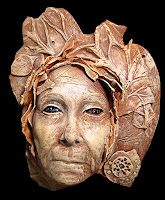 |
| "Demeter's Hands", Ceramic, 2024 |
A piece I'll be showing at the upcoming Tucson Sculpture Festival, at the end of March.Most people I've shown it to say nothing, which I assume is because it makes no sense to them, but then, most people aren't all that interested in mythology.
Demeter was the ancient Earth Mother, the Goddess of agriculture, by whose grace the seeds put down roots, the new life of spring emerged, and the harvest was harvested. And one of Her stories concerns the abduction of her daughter, Kore, by Hades, the God of the Underworld, of death. She was so angry and grieved so deeply at the loss of her daughter, that the world began to die, and people starved. So at last the Gods had to come to an agreement with Demeter, who had been vastly under appreciated. Kore could return to her mother for half of the year, and half of the year she dwelt in Hades, wife of the King of Death. Thus Kore, the maiden of Spring, became the mature Persephone, the liminal Goddess of both death, and rebirth.
I've always loved the image below, Greek bas relief that shows Demeter, Her snakes writhing around her, the holy snakes representing the serpentine, moving and endlessly renewing energies of the Earth. She is bearing the wheat, her gift to humanity, the "staff of life". Bread. How we take Bread for granted, Bread that was sustainer of our ancestors, at least, those that came from Europe and the Middle East.
Years ago I stood in a wheat field in Wiltshire, in the UK. I was there to visit a Crop Circle, being fascinated with that phenomenon, and I did stand in the middle of this huge field, impressed with the crushed pattern I stood in. But what I remember more strongly was standing in what seemed like a vast field of golden wheat, bending with the wind, moving like Demeter's serpents through the rustling, golden blonde wheat fields. That experience filled me with awe, with a sense of something primordial and sacred.
Grace. The Grace of Demeter.
Here is a poem I found while surfing around the internet. It was on a poetry site called allpoetry.com. I was struck by "You mistook my grace for leniency"...... indeed, that is the hard lesson we are learning now. To recognize that we are part of the Earth, and to live accordingly. We are rooted and sustained by the Grace of Demeter.
I am sorry to say that I couldn't find the name of the poet who wrote this poem to Demeter, except that she called herself "Unemployed Diva" on the site, which featured a number of her poems. I am grateful for her work, and will keep looking for her name to give her the credit she deserves.
I unfurl blazing fields of golden corn,
my bare feet cross the toiled earth.
My belly is round, awaiting the harvest.
I whisper, I chant, urging the planted seeds
to grow strong, to be bold in this endless summer.
I am a cornucopia of gifts, waiting to be given.
I was an oak that could not be shaken by the wind.
You saw a peach about to be bruised.
I can bring light and life, I can stretch spring and summer.
I am willing to lighten the load of the tired farmer,
to bless his harvest and spread grace through his house.
Yet, you chose darkness, you chose apathy, you chose condemnation.
I am lost amongst the the trees, drowning in the sea, my
naked feet are torn from the rough earth. The sun hides
from me, tears fall from my eyes staining the blank snow.
You mistook my grace for leniency,
My daughter’s stained lips crack
as she smiles up at me, her
skin marble, her eyes tired and bitter.
I will allow you light, I will allow you life.
But you must also suffer darkness
as you so carelessly cursed me.
I will dance upon the ice as you shiver
and pray for the sun to appear.
There is a Goddess within me.






























